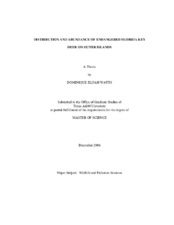| dc.description.abstract | Status assessments are compulsory to efficacious management of large-mammal populations, particularly for endangered species such as the Florida Key deer (Odocoileus virginianus clavium). However, a dearth of data regarding basic demographic parameters has limited status assessment and management of Key deer on outer islands. Traditional survey techniques for Key deer on Big Pine and No Name keys include road-counts, strip-counts, and mark-recapture methods. However, practical limitations render traditional survey techniques impractical for application on outer islands. Thus, assessment of current status and appropriate management is limited by a paucity of information regarding Key deer on outer islands. The purpose of my study was to evaluate the utility of infrared-triggered cameras and forward-looking infrared thermography (FLIR) to monitor occupancy and abundance of Key deer on outer islands, and to obtain baseline information regarding current distribution and abundance of Key deer in these areas. In addition, I wanted to further evaluate the advantages and disadvantages inherent in using baited camera-stations to estimate abundance of large mammal populations. I compared 3 frequently applied methods to estimate abundance from camera-based survey data. All outer islands exhibited estimated abundances considerably below carrying capacities, with larger populations occurring closer to Big Pine Key. Results indicated that other islands and complexes such as Ramrod Key, Water Key, and the Annette complex maintain only small sub-populations (e.g., ≤5 individuals) and other previously inhabited island complexes (i.e., Johnson complex and Summerland Key) no longer maintain sub-populations. Additionally, I compared abundance estimates from FLIR-based surveys to camera-based estimates. Although no test of accuracy was possible, camera-based survey methods consistently produced higher estimates of Key deer abundance on outer islands. Results indicate that aerial FLIR-based survey methods may be unreliable for the survey of large mammals in tropical habitats or areas exhibiting dense vegetation, and camera-based surveys should be the preferred method to survey Key deer abundance on outer islands. | en |


